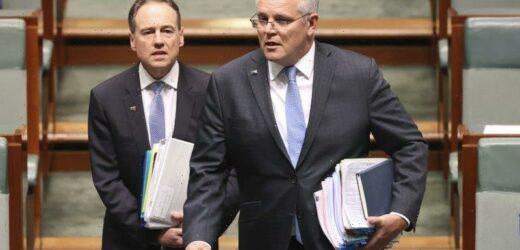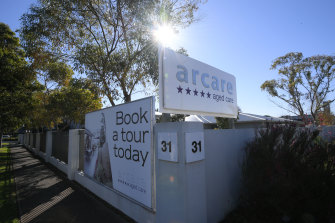For our free coronavirus pandemic coverage, learn more here.
As thousands of COVID-19 infections hit the elderly in aged care last year, something very powerful was, largely, being overlooked in Victoria.
Unlike other states, where public-sector aged care has been largely abandoned, Victoria has 178 aged care homes run by the state government.
The Arcare aged care home in Maidstone, where an outbreak this week spread to five people.Credit:Eddie Jim
Of 5600 elderly people living in these homes, how many died with COVID-19 last year?
Zero.
Across these centres, just 15 COVID-19 infections were detected.
Meanwhile, in the state’s 596 privately-run homes in the federally-funded and controlled system, there were 1988 COVID-19 cases last year.
Six hundred and fifty-five people died in these homes, often agonising and lonely deaths without families by their sides. In many cases, before their deaths those who perished had endured weeks locked in their rooms alone, in a vain attempt to protect them from the virus.
As much as it is a health story, fighting COVID-19 in Melbourne’s aged care homes is also an industrial relations challenge.
This week it transpired that staff at two aged care homes who tested positive to COVID-19 had worked across multiple centres: an Arcare home in Maidstone and a BlueCross facility in Sunshine.
The re-emergence of the virus in aged care was a key factor in prompting statewide lockdowns and once again confining residents of homes to their rooms.
The outbreak at Arcare Maidstone numbered five people, and by Friday appeared likely to have been brought under control. “The two residents who tested positive are both still asymptomatic at this stage and will remain in hospital for precautionary monitoring,” Arcare said on Friday. The staff members who had tested positive were also recovering, it said.
But while the Arcare outbreak was small compared to eruptions in other homes last year – St Basil’s in Fawkner, for instance, had 45 deaths and 223 cases – the reappearance of COVID-19 in aged care sparked a media firestorm.
It forced Prime Minister Scott Morrison and his Aged Care Minister Greg Hunt to field questions all week over whether Australia was once again failing to protect its most vulnerable.
Attention focused on workforce issues in aged care – specifically, why so many private homes have casual staff working across multiple homes.
Much of the spread of COVID-19 last year was caused by low-paid casual employees working second or third jobs to supplement their wages.
The 5600 beds in Victoria’s public sector aged care homes are funded federally, via the same daily funding mechanism private homes receive (their funding is also topped up by about $98 million a year from the Victorian government). The residents in these homes, generally linked to hospital services, are typically sicker and have higher care needs than those in private centres.
The wages in publicly-run facilities are usually better than most private sector homes; a comparison by the Australian Nursing and Midwifery Federation showed nursing staff at one major private aged care chain were paid around 25 per cent less for a mid-level worker.
And, crucially, few staff in the public system work across multiple sites.
This week Hunt pointed out the numbers of people working across multiple homes was not great; in metropolitan Melbourne, he said, 4.7 per cent of staff were employed across different care centres.
By Friday, the concern over aged care was so great Morrison said aged care workers would likely have to be vaccinated if they wanted to continue working in homes.
Canberra in 2020 started funding aged care providers across Melbourne to ensure staff worked at only one site, to prevent the spread of COVID-19. However it emerged this week that the rules had lapsed in November once areas around the nation were no longer designated as hotspots, and were only intermittently reinstated.
The discovery revived the question of why so many care staff had such poor working conditions.
“The casualisation of the aged care workforce has been an unmitigated disaster,” says campaigner Sarah Russell, who runs the lobby group Aged Care Reform Now.
Monash University aged care expert Joseph Ibrahim, who is also a working GP, says the casualised workforce in private homes was a big part of the spread of COVID-19 in 2020, and has focused attention on conditions for workers.
“Staff have never been paid enough to have a living wage,” he says, explaining why they work across multiple sites. “It suits the providers to have a casualised workforce too – you don’t have sick leave, you don’t have entitlements you have to worry about.”
He says that even workers with regular employment at one of the larger aged care operators, like BUPA or Japara, “might be employed by the one organisation, but you are working across multiple campuses”.
The Morrison government argues the question of whether to have a casualised workforce or not in aged care isn’t easy to answer. Aged Care Services Minister Richard Colbeck this week pointed in a Senate hearing to a case brought by a union last year to prevent a Sydney aged care centre dictating whether or not staff were allowed to work across multiple sites.
“The Health Services Union took a provider to court [for] trying to inhibit this person’s capacity to earn income. [It] was unlawful, that’s what Fair Work Commission found,” Colbeck told the hearing.
Lisa Fitzpatrick is Victorian secretary of the nursing union and says while there are some people in public sector aged care who work across multiple homes, “it’s not as common because you get eight-hour shifts – it’s not two four-hour shifts, as it often is in private care”.
“They also have nurse-to-patient ratios in public homes,” she adds, meaning there is a higher focus on strong infection control measures.
Canberra tried to address this issue after last year’s second wave in Victoria and this week the federal Department of Health indicated it was making progress at improving private aged care homes’ consciousness of fighting COVID-19.
More than 99 per cent of residential aged care providers now have a dedicated Infection Prevention and Control officer, a department spokesman says. “And nearly 22 per cent of these facilities have nominated more than one dedicated Infection Prevention and Control [officer],” he says.
Figures supplied by the Victorian government this week underscore the additional training of the workforce in public sector homes. They show nurses comprise over 80 per cent of the care workforce there.
By contrast, across the entire residential aged care workforce, around 25 per cent are nurses and 70 per cent are personal care workers, who receive far less training and cost less to employ.
Fitzpatrick says she recently dealt with an aged care worker working across five different aged care facilities, for an average of 140 hours a fortnight.
Aged care operators’ lack of willingness or ability to deal with the problem of workers being employed at multiple sites was also revealed by the federal Health Department this week, after The Age inquired about a federal government grants scheme set up last year to ensure aged care employees did not work in more than one facility. Those grants were paid to just 33 operators.
The total amount paid was $12.5 million – a figure described by Ibrahim as “very, very small”.
Russell agrees, saying the grants were a typical response in the privatised system and unlikely to have made much of a difference: “This pandemic is highlighting just how badly we have failed the aged care workforce.”
Most Viewed in Politics
From our partners
Source: Read Full Article



